
Why is structure in screenwriting important?
14a. Beginning, middle, and end . . . not always in that order
Are you a rebel who can’t be tamed? Do you see screenplay structure and think “Sheesh, how predictable!” We admire your need to break free of the norm and spread your creative wings, but we have a secret or two for you to consider.
Screenplays are structure. That’s what makes them screenplays! Much like drawings make comic books comic books, illustrations and speech bubbles are what define them as comics and nothing else.

It’s simply not an option to disregard structure. You can go ahead and try to redefine the art that has been perfected and crafted over the last century, but you’ll have quite the mountain slope to climb, and guess what? Unless you’re Gaspar Noé, you don’t have your hiking boots or a coat and it’s pretty damn cold on that there mountain!
Even people like director Quentin Tarantino obey structure (though he likes to pretend he doesn’t . . . oh, QT). Every story has a beginning, middle and end. Structure is how you get from A to B to C, all the while keeping your audience hooked to the screen.

The screenplay evolved into its current form
Screenplay form has mutated into what it is today through a century of trial and error by some of the finest movie minds ever seen. Sometimes geniuses of story write structured screenplays without even realizing their structure. Some lucky people are gifted with an instinctive structural storytelling gene.
The rest of us have to work out exactly why their work is so entertaining, thought-provoking, and emotional. We’re not jealous of their natural ability at all. We swear.

Some key points in every screenplay
Screenplays have mutated through time along with audiences. Writers early on realized audiences have to get to know a character before they can empathize on their journey – also known as Act 1.
Viewers get fidgety and expect an event to set things into motion within thirty minutes or so or they get bored – also known as the inciting incident. Writers also realized audiences feel like they haven’t been on much of a ride unless the protagonist reaches a seemingly intractable low point in the story, unsurprisingly called the point of lost hope.
Make your ending as juicy as possible. If there’s no satisfaction in the ending, audiences leave feeling devastated to have lost two hours of cat memes and playing Candy Crush for diddly squat. It seems so simple to read like this, but so many writers don’t follow these crucial elements that make a screenplay.

Tips to set up your screenplay structure right from the outset
One shortcut to good screenplay structure is establishing the inciting incident straight away. In a fairy tale introduction that starts, “Once upon a time there was . . .”, the inciting incident goes “Until one day . . .”. What is the event that forces your protagonist to act, that happenstance he or she can’t ignore? Then for your point of lost hope imagine the worst possible outcome for your character.
Getting these two crucial plot points in place and ready for action will cause the rest of your story to fall right into place. You’ll know just where each scene is heading, instead of your hero aimlessly swinging by McDonalds for a Quarter Pounder with Cheese and an Apple Pie™.

Knowledge of structure is eternally useful for any story you ever write for the screen or otherwise. Even in TV series, these plot points happen in each episode and also throughout the series as an overall arc.
The takeaway is that all screenplays in essence rely on the same structure. The sooner you understand the formula, the sooner you can write that gripping story!
14b. Beginning, middle, and end . . . not always in that order
Time to pick apart your favourite films or TV shows, ruining them for yourself completely! Just kidding – you’ll enjoy them in a whole new way. When you’re watching with a buddy, just sit in a cloud of your own smugness, knowing exactly why your friend is enjoying this certain scene so much.
Enjoy unravelling your enjoyment
In a few of your favourite movies/shows, identify:
- the inciting incident
- the midpoint and how it is marked by sex or death (literally or metaphorically)
- the act breaks
- the Total Mastery scenes at the end
Some easy movies to spot structure like the above are Disney movies.
Next step
Shape your story into the three-act structure outlined in this lesson.



